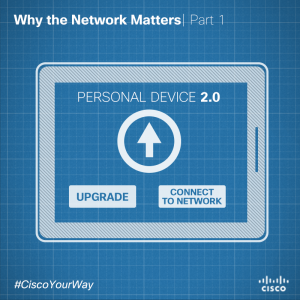































It's a critical time for enterprise IT as new mobile devices from Apple, Samsung and Google enter the market and operating systems are updated almost weekly. Apart from the new color and form factor options, this round of new technology features new operating systems and a proliferation of app updates, which IT leaders must be prepared to meet head on.
It's an exciting time for mobile technology, but it's also an important time for enterprises to look at not only meet the demands of today's mobile-enabled workforce, but tomorrow's as well. Basic mobility functionality is not and will not be enough, and a solid framework must be put in place to support the growth.
In this inaugural post of a four-part Network Matters blog series, I'll be discussing how IT leaders can rely on a network, built for all kinds of devices, to simplify the process of onboarding new mobile technology and free up precious IT resources. I would like to provide you with a deeper look at how having the right network in place can help ease the challenges of tomorrow that will be presented to IT departments due to device evolution and enable a culture of self-service for employee-owned devices.

An Architectural Approach to Mobility
During the last several months, we've seen a proliferation of devices and new operating systems penetrate the market. New mobile smart devices -available in new colors, shapes and functionality -are offering consumers more choices both for personal and work use.
How can enterprises prevent a proliferation of new employee-owned devices from burying your IT department and putting corporate data at risk? The most important step is to apply an architectural approach to mobility and BYOD policies. An architectural approach provides:
A Secure Network Supports Self-Service
A few months ago, I wrote a blog post about my recent trip to Palo Alto to be interviewed for Apple's Tech Talk series. Because Cisco is one of the largest enterprise users of Apple products today across the world, it was an interesting conversation to have about how the future of new devices and content will impact the enterprise.
One of the key points from my discussion is the importance of experience for mobile-enabled employees. We want IT to be the path of least resistance, and with a secure network, IT leaders can empower employees by showing them how to manage their own mobile devices on our network in a secure way. This can lead to more employee control and more control over IT resources.
The second post in this Network Matters blog series will advocate for an architectural approach to mobility that supports the need to look beyond current issues. It will focus on how organizations can prioritize their approach to new wireless network solutions, device management tools, mobile apps and cloud adoption as these components are driving the future of mobility.
How is your IT department preparing to onboard new mobile devices? Let us know via comment below or join the conversation on Twitter,#CiscoYourWay.
Additional Information:
 Tags quentes :
Mobilidade
Telemóvel
rede
Infra-estrutura
wireless
Comunicações Unificadas
architecture
mobile device
mobile workspace
Tags quentes :
Mobilidade
Telemóvel
rede
Infra-estrutura
wireless
Comunicações Unificadas
architecture
mobile device
mobile workspace